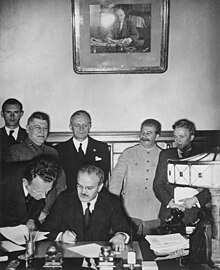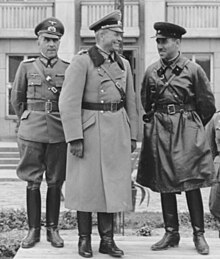Soviet occupation of Latvia in 1940
[4] In 1989, the USSR condemned the 1939 secret protocol between Nazi Germany and itself that had led to the invasion and occupation of the three Baltic countries, including Latvia.
The independence of Latvia was diplomatically recognised by the Allied Supreme Council (France, Great Britain, Italy, Japan, Belgium) on January 26, 1921.
In light of the German advance in the east, the Soviet government demanded an Anglo–French guarantee of the independence of the Baltic states, during their negotiations for an alliance with the Western Powers.
The German–Estonian and German–Latvian Non-aggression pacts were signed in Berlin on 7 June 1939 by Latvian foreign minister Vilhelms Munters and Joachim von Ribbentrop.
On the next day Adolf Hitler received the Estonian and Latvian envoys, and in course of these interviews stressed maintaining and strengthening commercial links between Germany and Baltic states.
Nevertheless, despite declarations that a state of war now existed with Germany, the inter-Allied military conferences of 4-6 September determined there was no possibility of supporting an eastern front in Poland.
Stalin then moved forward with his part of the Pact, ordering the Red Army on 17 September to cross the Soviet-Polish frontier under the claimed necessity to protect the Belarusians and Ukrainians in the territory of Poland, which Soviets argued "ceased to exist" in the wake of German successes.
[21] On 28 September 1939, Germany and the Soviet Union having partitioned Poland signed a border agreement, including a second secret protocol, handing Lithuania to Stalin in exchange for two Polish provinces.
[22] Subsequently, the Soviet Union further agreed to compensate Nazi Germany 7,500,000 gold dollars (or 31,500,000 Reichsmarks) for the Reich renouncing its "claims" on the Lithuanian territory it was to originally possess based on the September 28th agreement.
[23] The Soviet Union now occupied just over half of all Polish territory, and the Allied powers had demonstrated themselves incapable of military intervention on the Eastern front.
On 24 September 1939, warships of the Red Navy appeared off Latvia's northern neighbour, Estonian ports, Soviet bombers began a threatening patrol over Tallinn and the nearby countryside.
Moscow demanded that Baltic countries allow the USSR to establish military bases and station troops on their soil for the duration of the European war.
[25] During talks in Moscow, on 2 October 1939, Stalin told Vilhelms Munters, the Latvian foreign minister: "I tell you frankly, a division of spheres of interest has already taken place.
There are people who will say that these favourable conditions are of a temporary nature only, and that sooner or later we shall have to reckon with internal-political and foreign-political pressure on the part of the Soviet Union.
When those failed to develop into a general strike, the Soviets blamed that failure on the "irresponsible element which spoils the good neighbourly relations".
[citation needed] On 28 May 1940, the Lithuanian Minister in Moscow received a note from Molotov which dealt with the alleged kidnapping of two Soviet soldiers in Vilna.
Moscow rejected this proposal and cut off further discussion, soon showing and rapidly playing their hand: Soviet orchestration of events continued following the invasion, complete with protestors, who had arrived with the Red Army troops, organizing mass marches and meetings in order to create the impression of popular unrest: Accurate numbers for the losses the Soviets inflicted on Latvia are not available.
Baigais Gads is also a title of an openly antisemitic account of the events of the year penned by Pauls Kovalevskis, a Nazi sympathiser, in 1942).
Immediate confiscation of property and execution within 24 hours was decreed for diplomats abroad who refused to recognize the new regimes and return to Latvia.
[46] Later orders expanded the list of repressions, including anyone related to someone in hiding from the government or who had fled abroad—which act made them a traitor to the state.
That was when they discovered that the men were to be separated from the women and children: "In view of the fact that a large number of deportees must be arrested and distributed in special camps and that their families must proceed to special settlements in distant regions, it is essential that the operation of removal of both the members of the deportee's family and its head shall be carried out simultaneously, without notifying them of the separation confronting them ...
The Latvian national anthem played on the radio, and, as Chris Bellamy wrote: "the [anti-Soviet] rebellion broke out immediately after the news of Barbarossa".
Latvians did not only desert en masse from regular Red Army units, they also escaped from military training camps, which were part of the Soviet mobilization plan.
[47] Nazi Germany, however, had no plan or desire to restore autonomy to Latvia, even though they ordered Colonel Alexander Plesners to oversee formation of the Latvian Defence Forces.
Many Latvians fled in fishermen's boats and ships to Sweden and Germany, from where until 1951 they drifted to various parts of the Western world (mostly Australia and North America).
In July 1989, following the dramatic events in East Germany, the Latvian Supreme Soviet adopted a "Declaration of Sovereignty" and amended the Constitution to assert the supremacy of its laws over those of the USSR.
Approximately two million people joined their hands to form an over 600 kilometre long human chain across the three Baltic states (Estonia, Latvia, Lithuania).This demonstration was organized to draw the world's attention to the common historical fate which these three countries suffered.
In March 1990 candidates from the pro-independence party Latvian Popular Front gained a two-thirds majority in the Supreme Council in democratic elections.
A Pact of Mutual Assistance was signed[52] allowing the USSR to station a limited number of Red Army units in Latvia.
Subsequently, the Soviet Union conducted large-scale and systematic actions including murder and mass deportations against the Latvian population.













